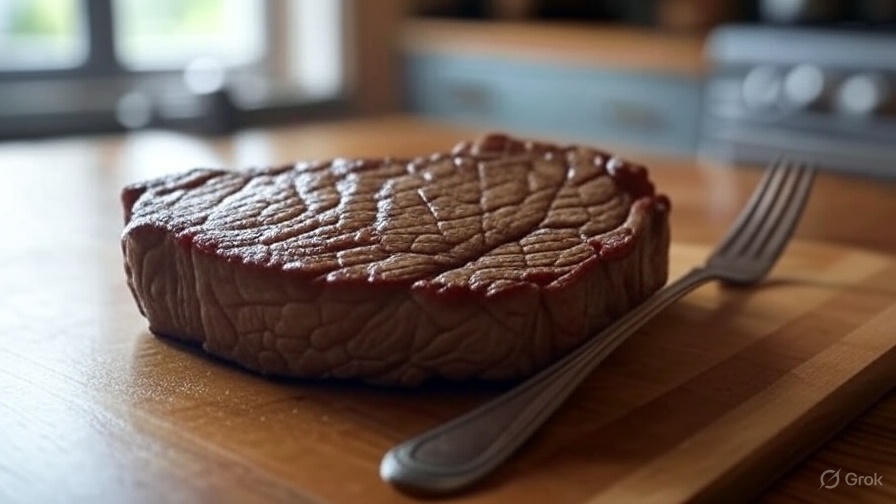How Big is a 3 oz Steak?
Picture this: you’re at the grocery store, staring at the meat counter, and the butcher mentions a 3 oz steak. Your mind immediately starts wondering – is that even enough for a meal? Will it leave you hungry? How does it compare to restaurant portions?
You’re not alone in this confusion. Most people struggle with visualizing meat portions, especially when it comes to raw versus cooked weights. A 3 oz steak represents a specific serving size that plays a crucial role in meal planning, nutrition tracking, and budget management.
The Real Size of a 3 oz Steak
A 3 oz steak measures approximately 3 inches by 3 inches and sits about half an inch thick. This compact piece of meat weighs exactly 85 grams and contains roughly 180-220 calories, depending on the cut and marbling.
When you hold a 3 oz steak in your hand, it feels surprisingly small. Many people expect steaks to be much larger, but this portion size aligns perfectly with nutritional guidelines. The United States Department of Agriculture recommends 3 oz servings of protein for most adults.
Raw steaks lose about 25% of their weight during cooking due to moisture loss and fat rendering. This means your 3 oz raw steak becomes approximately 2.25 oz after cooking. The visual size shrinks accordingly, making the cooked portion appear even smaller than the raw meat.
Visual Comparisons That Make Sense
Comparing a 3 oz steak to familiar objects helps you understand its true size. This portion equals the size of a standard deck of playing cards or fits comfortably in the palm of an average adult hand.
Think about a computer mouse – a 3 oz steak has similar dimensions. You could also compare it to a small smartphone, like an iPhone SE, though the steak would be thicker. These comparisons help when you’re shopping or planning meals without a kitchen scale.
Restaurant portions often dwarf this size. Most steakhouses serve 6 oz, 8 oz, or even 16 oz steaks as standard portions. A typical restaurant ribeye weighs 12-14 oz, making it four times larger than a 3 oz serving. This explains why restaurant meals often feel so filling.
Different Cuts, Different Appearances
The cut of steak significantly affects how a 3 oz portion appears. A filet mignon tends to be thicker and more compact, while a flank steak spreads out thinner and wider. Both weigh the same, but their shapes create different visual impressions.
Ribeye steaks have more marbling, which means more fat throughout the meat. This makes a 3 oz ribeye appear slightly larger than a 3 oz sirloin due to the fat content. The marbling also affects cooking shrinkage – fattier cuts lose more volume during cooking.
Strip steaks fall somewhere in the middle. A 3 oz New York strip appears rectangular, measuring roughly 3 inches long, 2 inches wide, and three-quarters of an inch thick. The consistent shape makes it easy to estimate portion sizes.
Skirt steak and flank steak create long, thin portions when cut to 3 oz. These cuts work well for fajitas or stir-fries because they spread out nicely in the pan. The thin profile means they cook quickly and evenly.
Nutritional Profile of a 3 oz Steak
A 3 oz serving of lean beef provides approximately 22-25 grams of complete protein. This amount supplies all essential amino acids your body needs for muscle maintenance and repair. The protein content varies slightly between cuts, with leaner cuts like eye of round containing more protein per ounce.
The calorie count ranges from 180-220 calories per 3 oz serving. Lean cuts like tenderloin stay closer to 180 calories, while marbled cuts like ribeye reach 220 calories or more. The fat content drives this calorie difference.
Iron content in a 3 oz steak provides about 15% of your daily iron needs. This heme iron absorbs more easily than plant-based iron sources, making steak an excellent choice for preventing iron deficiency. The serving also contains significant amounts of zinc, selenium, and B vitamins.
Saturated fat content varies dramatically by cut. A 3 oz sirloin contains about 2 grams of saturated fat, while a 3 oz ribeye might contain 4-5 grams. This difference matters for people monitoring their saturated fat intake for heart health.
Cooking Methods and Size Changes
Grilling a 3 oz steak over high heat creates the most dramatic size reduction. The intense heat causes rapid moisture loss, shrinking the steak to about 2 oz cooked weight. The surface area decreases noticeably, and the thickness reduces by about 20%.
Pan-searing produces similar results but with slightly less shrinkage. The controlled heat of a stovetop allows for more even cooking, which helps retain more moisture. A 3 oz raw steak typically weighs 2.3-2.4 oz after pan-searing.
Slow cooking methods like braising or sous vide preserve more of the original size. These gentle cooking techniques minimize moisture loss, keeping the final portion closer to the original 3 oz weight. The texture becomes more tender, but the size remains more consistent.
Broiling creates results similar to grilling. The high heat from above causes significant shrinkage, and the steak loses considerable volume. The final portion weighs about 2.2 oz and appears much smaller than the raw meat.
Meal Planning with 3 oz Steaks
A 3 oz steak serves as the perfect protein centerpiece for a balanced meal. Pair it with roasted vegetables and a small portion of starch like rice or potatoes. This combination creates a satisfying meal without excessive calories.
For larger appetites, consider serving two 3 oz steaks instead of one massive portion. This approach allows for better portion control while still providing a substantial meal. You can prepare them with different seasonings or cooking methods for variety.
Steak salads work wonderfully with 3 oz portions. Slice the cooked steak and arrange it over mixed greens with vegetables. The protein adds substance to the salad without overwhelming the other ingredients.
Stir-fries benefit from 3 oz steak portions because the meat gets combined with vegetables and sauce. The smaller portion size allows the steak to distribute evenly throughout the dish, creating balanced bites.
Budget-Friendly Aspects
Buying 3 oz portions helps control food costs effectively. Instead of purchasing large, expensive steaks, you can buy smaller portions or cut larger steaks into 3 oz servings. This approach reduces waste and stretches your grocery budget.
Freezing individual 3 oz portions makes meal planning easier and more economical. Wrap each portion separately and label with the date. This method prevents you from thawing more meat than needed for a single meal.
Premium cuts become more affordable when purchased in 3 oz portions. A small filet mignon feels more reasonable than a large one, even though the price per pound remains the same. The smaller portion size makes luxury cuts accessible for special occasions.
Restaurant Portions vs. Home Portions
Most restaurants serve steaks ranging from 6-16 oz, making their portions two to five times larger than the recommended 3 oz serving. This explains why restaurant meals often provide enough food for multiple meals.
Chain restaurants typically serve 6-8 oz steaks as their “regular” size. These portions contain twice the calories and protein of a 3 oz serving. Many diners consume these larger portions without realizing they’re eating multiple servings.
Fine dining establishments often serve steaks in the 8-12 oz range. These upscale portions focus on quality cuts and preparation, but they still provide much more protein than nutritionally necessary for one meal.
Understanding these differences helps you make informed decisions when dining out. You might choose to eat half the restaurant portion and save the rest for another meal, or you might opt for smaller appetizer portions when available.
Health Considerations
A 3 oz steak fits well within most healthy eating patterns. The portion provides substantial protein without excessive calories or saturated fat. This makes it suitable for weight management and muscle building goals.
People with heart conditions should pay attention to the cut they choose. Lean cuts like eye of round or sirloin provide the protein benefits with less saturated fat. Fattier cuts like ribeye should be consumed less frequently.
The portion size helps prevent overconsumption of red meat. Health experts recommend limiting red meat intake, and 3 oz servings make it easier to stay within recommended guidelines while still enjoying beef occasionally.
Athletes and highly active individuals might need larger portions to meet their protein requirements. In these cases, two 3 oz servings might be appropriate, or the steak can be combined with other protein sources throughout the day.
Cooking Tips for Small Portions
Small steaks cook quickly, so careful attention prevents overcooking. Use a meat thermometer to check doneness, as visual cues become less reliable with smaller portions. The internal temperature should reach 135°F for medium-rare.
Let the steak rest for 3-5 minutes after cooking. This brief rest allows the juices to redistribute throughout the meat, ensuring maximum flavor and tenderness. The resting time is crucial for small portions because they lose heat quickly.
Season the steak generously before cooking. The high surface area to volume ratio means seasonings have more impact on smaller portions. Salt, pepper, and herbs create more noticeable flavor changes than they would on larger steaks.
Use high heat for quick cooking methods. A 3 oz steak benefits from intense heat that creates a good sear while keeping the interior tender. Preheat your pan or grill thoroughly before adding the meat.
Storage and Preparation
Fresh 3 oz steaks should be used within 2-3 days of purchase. Store them in the refrigerator at 40°F or below, preferably in the coldest part. Wrap them loosely in butcher paper or place them on a plate covered with plastic wrap.
Frozen 3 oz portions can be stored for 6-12 months in the freezer. Wrap each portion individually in plastic wrap, then place in freezer bags. Remove as much air as possible to prevent freezer burn.
Thaw frozen steaks in the refrigerator overnight. This slow thawing method maintains the best texture and safety. Avoid thawing at room temperature, which can promote bacterial growth.
Marinating works well with 3 oz steaks because the smaller size allows marinades to penetrate more quickly. Even 30 minutes of marinating can significantly impact flavor, though 2-4 hours provides optimal results.
Conclusion
A 3 oz steak represents the perfect balance between satisfaction and nutrition. This palm-sized portion provides substantial protein, essential nutrients, and culinary enjoyment without excess calories or cost.
The key to success with 3 oz steaks lies in proper preparation and realistic expectations. These portions work best when combined with vegetables and other foods to create complete, satisfying meals. They’re not meant to be massive, restaurant-style centerpieces but rather components of balanced nutrition.
By understanding the true size and nutritional value of a 3 oz steak, you can make better decisions about meal planning, grocery shopping, and overall health. This portion size supports sustainable eating habits while still allowing you to enjoy high-quality beef as part of a varied diet.
The next time you see a 3 oz steak, remember that good things come in small packages. This modest portion delivers big on nutrition, flavor, and satisfaction when prepared and served thoughtfully.







